When it comes to cutting the flower spike on orchids, a lot of questions and insecurities flourish, especially if this is the first time you’ve cut an orchid spike. How long should the spike be? Where should I cut it? How do I encourage reblooming? How long do I leave the spike? There is one basic element around the questions above circulate: the orchid node. So, let’s dive into what an orchid node is and go deeper from there.
An orchid node is a triangular growth nodule, forming an elevated budge on the flower spike where new growth can occur. New stems, buds, or flower spikes may develop from older orchid nodes.
Not all orchid nodes are productive, and in fact, most are dormant.
If something were to occur with the existing flower spike, like break off due to an accidental drop, a new flower spike can develop from the orchid node.
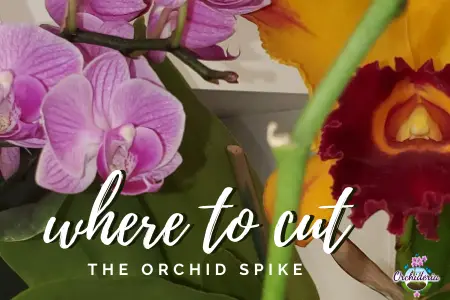
Besides being an origin of new growth, orchid nodes are also a “plant booster” in the sense that orchid nodes concentrate more natural elements that fight off infections. Orchid nodes look similar to fish scales and sometimes grow plant tissue around them that imitates a tiny leaf.
If your orchid is healthy but gets infected from an open cut, bacterial will travel down through the spike aiming to get to the stem. Once the bacteria encounter an orchid node, the defense system takes over and attacks the bacteria.
Not all orchids are successful in fighting off pathogens this way, but it’s in the orchid node where this line of defense is most highly concentrated.
The space in between orchid nodes are called internodes. This is important to observe because it’s a good indication of how a healthy orchid should grow. When the plant has enough energy to produce new plant cells and develop a healthy flower spike, the distance between the nodes should be constant and somewhat equal.
A shorter distance between orchid nodes signifies something happened (lack of water, fertilizer, or sunlight) that didn’t give the orchid the quantity of nutrients it needs to keep producing steady growth. Once the flower spike is nearly all developed, the energy will be redirected to creating buds. This is evident by the decrease in the internodal distance toward the end, which drastically shortens.
In other plants, internodes are where pruners focus their cuts to form intricate and elegant plant designs, such as the bonsai design. The length of the internode will determine how well a plant can be timed to form intricate designs, imposing branch growth.
A pruner will never cut right on top of the plant node, knowing that this is extremely important to maintain intact. They won’t cut too far above it either, since this piece will wither and die off. They find the furthest node and make snipping accordingly, close to the node.
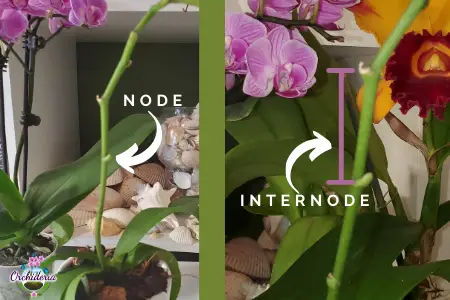
Unlike other household plants and some crops and trees, orchid nodes don’t produce leaves as a normal cycle of life. They may sometimes produce leaves from the flower spike as a form of “keiki”, which is a baby orchid.
This new plant will develop into a distinct, mature plant over the course of a few years. You can read more about orchid keikis in this article, where I focused on the major questions about keikis. Keikis will develop from the orchid nodes on the flower spike (mostly in Phalaenopsis orchids), which is why it’s important to know where the orchid node is.
Nodes in other plants may also produce leaves or roots, but as a normal life cycle, not as an exception. In a Phalaenopsis orchid, the leaves will not branch from the flower spike nodes, only flower spikes and buds.
These questions are normal and you’re doing the right thing: searching for information and answers. That is the best action at this time: research. Let’s get to the other 9 questions about flower spikes.
1. Is it an orchid spike or root?
Now that you know what an orchid node on the flower spike is, a related question occurs before that—long before. Is it a flower spike at all? When new growth develops our anxieties rise. Is it another root? Is it a flower spike? How can I tell the difference?
An orchid root will be soft, round, and light green. There are no hard, triangular bumps on it and the entire roots will change colors when it is watered.
As for the flower spike, it will develop in between the leaves, usually on the opposite side of the former spike, and be darker green or red. The end tip of a flower spike is sharper, pointier, and develop triangular spikes.
Depending on the orchid, the flower spike is thicker, but in the beginning, it will be fine, slim, and tender (easily breakable, too).
If you’re not sure whether the new growth is an aerial root (this article about aerial roots and why they’re important is a little guide I wrote about caring for aerial roots) then give the orchid time to tell you.
The orchid is in no rush, and you shouldn’t be either. It can grow out to the side, like most of my unruly Cattleya roots, or it will turn toward the light source, heading up toward the window or grow lights.
Either way, leave your orchid alone. This is the one most important rule in all orchid care—leave the plant alone. 😊 Too much tender loving care and you can suffocate the poor plant to its death.
You will be prone to over-watering, changing potting medium, trying full water cutler, adding fertilizer nutrients, and so on…
Orchids are not plants that like to be touched, interacted with, or even manipulated by humans. They like their space… So whether it be a root or a flower spike in formation, leave the orchid alone.
2. How long does it take to grow an orchid spike?
This answer will depend on the species and genus. I’ll take Phalaenopsis as my first example since it’s one of the most common orchids. From the moment the new growth appears, like a little bump on the side of the stem to the fully developed spike, it could be from 2 to 3 months.
If your Phalaenopsis orchids are outside the amount of sun will be more, which translates into more energy from Photosynthesis. They will grow faster, but this also depends on your region and the time of the year (season). In this article about the differences and observations about growing Phals outside, I detail more into the inside/outside transition.
3. What do I do with orchids when the flowers fall off?
You have two options when the buds fall off the spike, and what you want your orchid to do will direct your actions.
If you think your orchid has had a rough year and would benefit from a short rest, producing stronger roots, and focusing on establishing a healthy orchid, then cut your spike down to above the very first visible node near the stem.
Leave about half an inch to an inch (1.5 to 2.5cm) above the orchid node but not much more than that. This action of removing the green flower spike will force the orchid to focus its energy elsewhere, so root development starts.
If you want the orchid to attempt another flower and produce a bloom, then you’ll cut above the very last orchid node, leaving the majority of the stem intact. Since the orchid will not need the strength to grow an entire flower spike, it still can focus on sending energy to the very end of the spike.
This forced reblooming tactic doesn’t work with all orchids, but only orchids that rebloom naturally. Phalaenopsis orchids will rebloom above the last orchid node, and you can double the pleasure of seeing your orchid in bloom for longer periods overall.
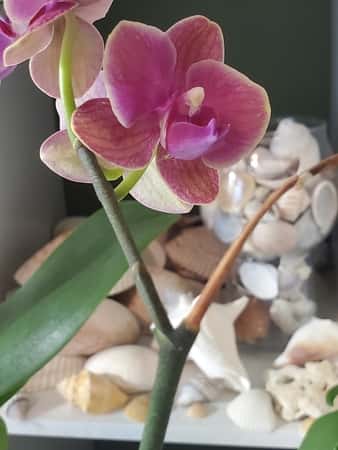
In this image, the Phalaenopsis Orchid has a flower spike that branched into 2. One has already flowered and is ready to cut, the other still is green and very much alive. In this case, it’s best to wait until the flowers fall off the entire spike before cutting either. Better safe, than sorry.
This second method will place more stress on your orchid. It’s like you’re forcing your employees to work overtime without any added benefits or payoffs. The orchid’s energy drains from producing a new spike at the end, which could have been redirected for healthy root growth (which is more important).
We’ve gotten into a habit of forcing orchids to rebloom when we want them to. I read a lot of articles about how to get the most out of your orchid. I understand the reasoning behind this, we all want beautiful blooms, but…
The orchid if working double-time, and will display signs of being weaker after the second bloom has fallen off. Be sure to fertilize adequately and provide a good source of light and water during this process, since you’re placing your orchid through unnecessary stress. If you are emotionally okay with slowing down your orchid’s growth, then snip above the top orchid node, near the end of the spike.
Some orchids will naturally bloom twice a year (Vandas bloom three times a year but not on the same spike). Other orchids, and some but not all Phalaenopsis species included, will not ever rebloom. They are just genetically reprogrammed to not rebloom.
When you buy an orchid, check with the seller to get that specific information so you don’t place unnecessary stress on your orchid.
4. Where do you Cut an Orchid Node?
I think I got ahead of myself and answered this question with the third one, above. After your orchid has bloomed, find the orchid node closest to the stem. You are going to cut in the internodal section, leaving an inch or less above the node.
If you snip too far above the node, the portion of the root will rot instead of drying up. If you cut the flower spike too close to the node, there might not be enough room for the orchid to stand up a fir chance of fighting off infection.
This applies to Phalaenopsis and other monopodial orchids. If your orchid is sympodial, like a Cattleya, then you’ll want to snip the flower spike as close as you can to the pseudobulb, leaving just a little stump of a spike left. (Check out this article on orchid anatomy to better understand the difference between monopodial and sympodial orchids.) Be extremely careful not to cut the pseudobulb or do more damage to the leaf.
5. How do you induce reblooming from the same spike?
To stimulate reblooming is not the best practice for your orchid unless you have specifically purchased an orchid that reblooms with vigor on the same spike. If your genus and species (Remember, Phals include some species that rebloom, other won’t) is a rebloomer, then, by all means, let’s do this!
Find the very last orchid node, before the actual spurt of flowers developed. You need to cut the old spike even if it’s still green above that last node. Apply a tad bit of cinnamon on the orchid cut, since you have severed live plant tissue and created an entry port for bacteria and microorganisms.
This will induce the orchid to evaluate its energy flow. Since the majority of the spike is still plump, juicy, and perfectly healthy, then it might aim for another bloom. You can induce and orchid to do what you want but whether it does or not, is up to the orchid.
6. How does cutting the spike induce root growth?
If you decide your orchid has done enough this year and deserves a small vacation for all it’s hard effort and work, then cut the spike back to the closest orchid node. This severing of the spike will automatically induce the orchid to work on root growth since new roots will be necessary for any future maturing of the plant.
Some orchid enthusiasts will not prune the flower spike, leaving it on until it turns brown, dry, and crispy. Then the flower spike breaks off with ease. I prefer this method because it doesn’t leave an open wound on the orchid, which is always a hazard in the long run.
While the spike dries, the energy is transported to the new growth, but this isn’t as automatic as just snipping it off while still green. New roots will grow, but it might take a little longer (a few weeks longer) to put out that effort. This is how the orchid grows and dies in nature, so I try to imitate that cycle.
I’ve read somewhere (can’t remember now where) that if you leave the spike on and let it turn brown, you risk a rotting spike. I have never had this happen to me—ever. I water and mist the same way I’ve always done, and never has a spike rotted or gone mushy on me.
I researched this too, unfortunately, to find no decent answers. I’m not sure if that theory has a scientific basis behind it, but I believe it doesn’t. If you have had this happen to you, please comment below so I can add that into the article.
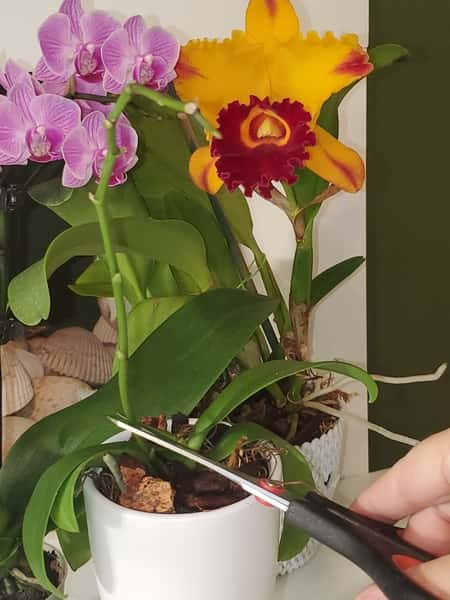
7. Where do you cut double spiked orchids?
Oh, lucky you! Double spikes! I bet your orchid was beautiful in bloom! For a double spiked orchid, sometimes I like to get a bit risky and try to cut one back at the stem above the orchid node, but the other spike, the healthier spike, I leave on the orchid, only cutting above the last node.
Don’t ever cut all the spikes at the end, inducing new growth on all the spikes. It’s hard enough for the orchid to rebloom, depleting its energy supply. If you induce spike growth on all the spikes, you’ll be stressing your orchid to its maximum.
If you can, and this is what I do most, is to leave the spikes on until they turn brown, then remove them. Yes, it’s unsightly and doesn’t fit the floral decor, but it’s the healthiest way to keep tour orchid productive. You also need to take into account what the orchid did last year. Did it rebloom last year too? If yes, it might be time to let your orchid rest.
Even God gave a 7-year sabbatical rule, to not plant the ground year after year, allowing the soil to rest. This rule still applies to modern-day farming, as farmers rotate the crops on the field (I’m from Kansas, so this part I’m pretty familiar with 😊).
So, please don’t force your orchid to rebloom year after year with no break. Even if your orchid has double spikes, just pick one to induce reblooming and cut the other one back.
8. When to Leave the Orchid Spike On?
After all the blooms have fallen off, the spike will naturally start to shrivel. The browning starts at the tip and works its way back to the stem, relocating the energy that is in the spike to other places. Leaving the spike on the orchid will not hurt or hinder the orchid in any way.
If you see a bacterial infection, fungus, or mold developing of the spent flower spike, then cut the spike back to above the very first node. In smaller Phalaenopsis, this is less than an inch. In bigger Phals, this could be three to four inches. You don’t want to risk the bacteria spreading to the stem, and removing the entire stem is the best option.
Otherwise, in all other cases, it’s best to leave the stem on even if it’s unsightly and ugly. When it’s completely dry, then remove it.
9. Can you replant an orchid flower spike
Let’s say the Phalaenopsis orchid has a beautiful blossom but my clumsy but loving dog Max comes in my home office, and—wham! The orchid pot is one place and the flower spike is another.
I’ve tried to use glue, tape, sphagnum moss, and even the Sphag and bag method mentioned here to reattached the orchid to the spike. I’ve seen it done, but that’s just not my gift, I guess.
If placed in water, will the flower spike grow into a healthy orchid? No. I’ve only had this work if the break had a part of the stem on it. The stem is the vital part of the orchid, and is what keeps the orchids alive.
You can have root rot, and rescue the orchid. You can have leaf rot, and still rescue it. But once your orchid gets stem rot, it’s almost impossible. There has to be a stem to make any progress in rescuing orchids. I’ve never had success with just the spike.
You can read about the Sphag and bag method here, where I explain how to revive an orchid that has been seriously damaged. Again, the orchids I’ve revived always had at least part of the stem.
So I place the broken spike in a glass vase and resist the urge to cry.
Dendrobiums are notorious to have grown roots from broken canes, but they have the energy supply stored in the cane to do so. A cane is another form of a pseudobulb, just thinner.
A flower spike by itself is almost impossible (emphasis on almost—give it a try, you’ve got nothing to lose) to revive to the point of growing again.
Orchids aren’t worms that you split in half and they’ll be ok. <– That’s actually a myth by the way. The head portion survives growing a new tail, but the tail portion doesn’t grow a new head. In this sense, orchids don’t “regrow” either… Once that flower spike is severed, it’s gone.
Don’t Stop Learning!
If you want to be included in more information and get a 14-page fertilization guide, please sign up for my newsletter. I don’t spam, but send emails out bi-monthly with some curious topics of interest. If you want more information, click here to go to a specific page on this website where I explain it more in detail.
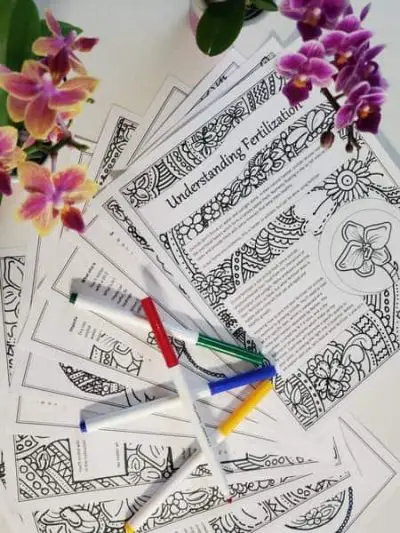
Also, if you are looking for an orchid journal to keep your notes specifically about orchid care, check out my 2 solutions for that on this page. If note-keeping isn’t your thing, then there is a free excel spreadsheet that you can download. Click here for more information on how to do that.
If you subscribe to my newsletter, I will send you a 14-page guide on the main tips of orchid fertilizer. It is downloadable and you can print it out on your computer. I designed the guide to double up as a coloring book, just to make it fun.
Enjoy your cut orchids while you can and design the cut portion into a floral design. Why not? Orchid nodes are important when it comes to fighting off bacteria, motioning the growth development of the orchid, and knowing where to cut the flower spike after the blooms have fallen off. If there is something that I missed in this article, please mention it in the comments below. I’m by no means an orchid expert, but learn so much by interacting with other orchid growers.
If you want to know more about orchid nodes, this article, “Where do I cut the flower spike when it is finished? ” written by the American Orchid Society is an good place to start.
” written by the American Orchid Society is an good place to start.
Happy Cultivating!


Hi there,
thank you for your informative website on all things orchid! This is regarding the flower spike of a healthy thriving phal: the plant is now in the same pot for three years. In the second year, the single short flower spike, after having lost its nine flowers, extended for at least another 2 feet, branched out, and developed 20 flowers, which are now, after about six months of bloom, almost all wilted. However, the plant doesn’t seem to want to stop flowering and is currently in the process of once more extending its spike a little, pushing out new flowers past the place of the old ones. After three years, I would like to repot the plant this year and give it a break for leave and root development of which little happened during the past two years. Can, should, I simply cut off the spike?
Hi Frank,
Yes, sometimes an orchid does get confused about when it wants to bloom and doesn’t allow itself a break. If your orchid is healthy, then there wouldn’t be a problem with leaving the spike since it doe so well with blooming. Since you want to repot, go ahead and cut the spike. this will refocus the energy into growing new roots as it adjusts to the new potting medium. It might set the orchid back a bit with the new media, but in time, it will grow again as it once was.
-Amanda
Hello! I couldn’t figure out how to leave my own comment so I replied to this one, I apologize.
I have a Phalaenopsis orchid. It has one spike (being a smaller/younger plant, it’s only about 6-7 inches long) but this one spike has developed three branches! All from one node on the spike about 2/3rds of the way up. It is done blooming. The entire spike is healthy and green, including all three branches. I felt like it’s time to trim all my orchids, but this one I’m not sure how to go about trimming it. Should I cut towards the bottom above the first node and remove the entire spike and all three branches at once? Should I trim each branch back a certain length? Or should each branch be trimmed differently?
I’ve searched all over the internet and can’t find any information on this topic other than a few forums or articles discussing the fact that some orchids branch. But nothing on the care of spikes that have multiple branches.
Any information you could give me would be much appreciated. Thank you so much!
Hi Courtney,
No need to apologize. I’m not to happy with the way the comment section is set up either, so no worries. LOL.
With the orchid branching out that much, I’d leave it on. It’s a happy, healthy orchid. 🙂 Congratulations. I have a Phal that does that, and it goes out to the sides everywhere. It also is quite the rebloomer. This is the way it grows and it’s happy like that. Only cut back the spike if you see that it is turning brown. That’s a sign the orchid has decided it doesn’t want to do anything else with the spike. In that case, cut it down close to the flowering node at the stem of the orchid, about 1 inch above that. If it’s a tiny orchid, then cut closer to the node. It’s more likely though, that the spike will develop new buds in the future. So check to find any browning. If it’s browning, then there is no possibility of reblooming. Let the orchid tell you what it wants.
-Amanda
Can uncovering the node and exposing that side bump weather ( to be spike or Kikie) encoaraging its growth?
Hi Rosie,
I haven’t heard of that actually increasing the growth. I’ll check up and see what I can find about that and get back to you.
When working with Phal. flower nodes, if it has a brown and dead covering over the node, is that note viable or it dead too? I live in a senior citizen complex and am asked to repot their orchids or just don’t want them any more since they are not blooming and most of these orchids are trying to survive. Many of these phals have nice green stems but have dead node coverings. Should I cut the green spike just above the first dead node above the stem and treat with cinnamon and let the plant get to work on roots??
Thanks for all the info.
My orchid, which I purchased in early November 2022, has started to get brown and shriveled on the end of the spike(?). I thought “OMG I killed it already!” I’m so happy to hear this is normal.
I heard of reblooming and looked it up on Pinterest to see how to do that. So happy I tapped on your article!
So informative! I certainly am saving it and will be referring to it often. I’m planning on giving my double spike(?) Orchid a vacation and letting it wither down and then cut it down.
1 question: Should I let the spike shrivel/turn brown way down to where I will cut it before breaking or cutting that off? I was unclear about that.
Please help me identify what the green lump is at the end of my phal . root .
The nodes on one of my orchids has a brown color around it. Is it a healthy node or not?
My Pham quit blooming and sent up two spikes. They both have bloomed and have leaves and air roots. Can these both be cut and start 2 new orchid plants?
Hi Dee,
Yes, they can. They don’t need to stay on the plant after they have formed roots and leaves themselves.
-Amanda
Thanks for such great info, Amanda. I’m an orchid novice, but I purchased at Lowe’s a Phal in one of those tiny pots. It has since stopped blooming, and I am wondering if I should replant it – the roots look so crowded.
I read somewhere that a bloom spike should always face the same direction. I have always rotated my phals on a regular basis to keep their growth even, regardless of a bloom spike. Is this harmful?
Hi Donna,
Orchids don’t like change. When you rotate them, the leaves and spikes will adjust (ever so slowly) to face the sun, which demands huge effort and energy. Especially when they are in bloom, they are already using a ton of energy, so there isn’t much left over to adjust for the change. It’s best if you keep them in one position the entire year. Some growers only move them when they are in bloom to a more visible place, like the dining room table – just an example. They won’t like it, preferring to be in one spot forever. But they do that to display the flowers. So to answer your question, I wouldn’t say its overly harmful, but it’s not what I would do.
Best regards,
Amanda